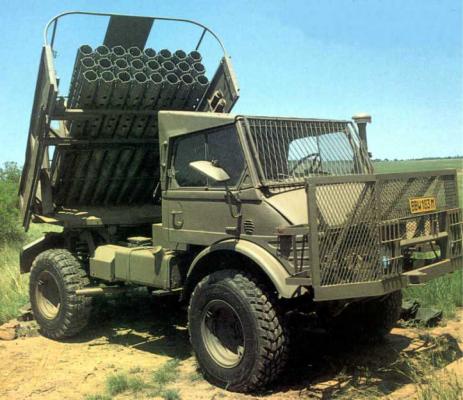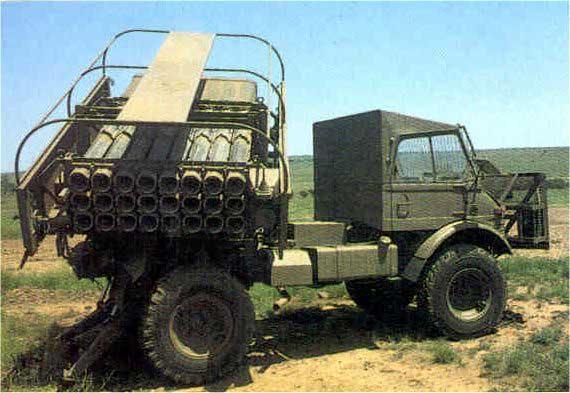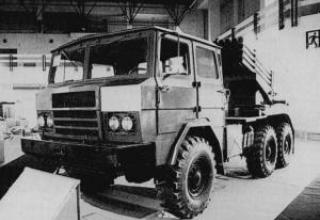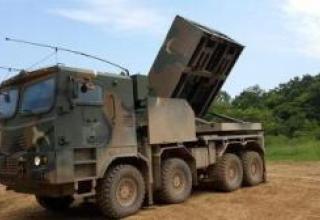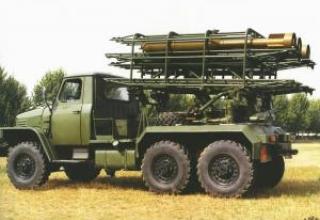The Republic of South Africa began developing its own 127 mm multi-barreled Valkiri (Valkiriya) jet plant in 1977. The development of the Valkiri was a reaction of South Africa to the successful use of Soviet Grad MLRS systems during the civil war in Angola in 1966-1989 and in occupied South Africa, Namibia.
The main developer of the system is the South African corporation Armscor, the unguided shells were developed by Somchem Division of Denel (Pty) Ltd.
The first prototypes of Valkiri were manufactured in 1981. The system was adopted by the South African National Defence Force (SANDF) in 1982 under the designation "Valkiri" Mk 1.22 and in the same year the first batteries took part in hostilities in Angola. Designed primarily to defeat exposed manpower and unarmed military equipment, the high mobility and low visibility Valkiri Mk 1.22 has proven effective against the infantry units of the Popular Movement for the Liberation of Angola (MPLA) and partisan units.
The system has been exported to a number of African States. Currently, the Valkiri Mk 1.22 MLRS is in service with the armies of Sierra Leone (6 combat vehicles), Zimbabwe (8 combat vehicles) and Malaysia (12 combat vehicles).
In addition to the standard Valkiri Mk 1.22 MLRS, the South African army uses its light towed version Mk 1.5, adopted in service in 1988. The artillery part of this system has twelve barrels and is mounted on a single axle trailer, which can be towed by a light truck. It is equipped with 127mm unguided rockets, 1.4m long and weighing 30kg. The maximum firing range is 5.5 km. The design of the Mk 1.5 launcher allows for direct-fire if necessary.
In 1985, work began on the development of the new generation 127mm Mk.II Valkiri Mk.II rocket launcher, designed to replace the Mk 1.22 system. These systems were introduced to the South African army in 1989 under the name of Bataleur. Bataleur" MLRS has a range of up to 36 km and improved combat characteristics.
Composition:
Valkiri" Mk 1.22 includes:
- launcher (see diagram),
- unguided rockets,
- fire control system
- transport and charging machine (TZM).
Each battery, consisting of eight launchers, includes a fire control vehicle, which produces data for firing, as well as a vehicle with meteorological instruments.
The Valkiri Mk 1.22 launcher is based on the Unimog U-140L (4x4) of Mercedes-Benz, Germany. The design of the launcher is based on the classic scheme, but it is implemented quite originally: a package of 24 guides, which are artillery part of the PU, mounted on a swivel frame, imitating an ordinary truck body. In a hiking position, the frame is closed with a removable awning, which allows you to disguise the launcher as a truck. The frame with the barrel package can be aimed at the target in the vertical plane in the range of angles from 0° to +50°, the angle of guidance in the horizontal plane is 110°. Lifting and swinging mechanisms are hydraulically actuated. Hydraulic actuators are also equipped with jacks, on which the aft part of the launcher is hanged when it is put into combat position.
A panoramic sight is used to point the launcher at the target, data for firing are prepared by the control machine. Firing is controlled from the cockpit or by a remote control.
Shooting is carried out with 127-mm uncontrollable rockets, 2.68m long and weighing 53kg. Maximum range is 22km and minimum range is 8km; special spoiler rings are worn on the head of the projectile at minimum range. Dispersion in direction - 290m, range - 200m. The shell's shrapnel-head contains 8500 ready-made shrapnel in the form of steel balls with a diameter of 6 mm, ensuring the defeat of enemy manpower in the area of 1500 square meters. The head unit can be equipped with a non-contact and contact fuse. The rocket engine is an upgraded V3B "Kukri" air-to-air missile engine. Interval of descent of shells from the rails - 1 s.
Charging of the launcher is performed manually. The calculation of two people performs this operation within 10 minutes. For ammunition delivery a transport and charging machine is used, the body of which is equipped with a folding ramp that provides convenient loading and unloading of missiles. Each TZM can carry up to 48 missiles.
Self-propelled launcher has a diesel engine rated at 99 hp. When driving on the highway, it reaches a speed of 90 km / h. Due to the air pressure control system in tires, the unit has a high cross-country ability. Without prior preparation, it is able to force a ford depth of 0.6m, the range on the highway is 450km. The launcher is equipped with a radio station and an infrared night vision device.
Characteristics:
| Range of fire, km : - maximum - minimum |
22 8 |
| Caliber, mm | 127 |
| Weight of projectile, kg | 53 |
| Number of guides | 24 |
| Guide length | 3000(2950) |
| The duration of the full salvo, s | 24 |
| Recharging time, min | 10 |
| Calculation, man. | 2 |
| Weight in combat position, t | 6.4 |
| Overall dimensions in camping position, mm: - length - width - altitude |
5350 2300 2320 |
| Engine power, hp. | 99 |
| Maximum speed, km/h | 90 |
| Power reserve, km | 450 |
Testing:
According to data dated July 2018, the Soviet side sold the rockets and other components of the Hurricane system (it is worth understanding the Hurricane MLRS) to the Syrian side. Some of these rockets were handed over to the Hezbollah movement in the early 2000s.
In 2002, Alyazhedinov Vadim Rashitovich, Skirda Viktor Andreevich was awarded the S.I. Mosin Prize for his work on the topic: "The Hurricane multiple launch rocket system with increased accuracy and heap of fire.
Sergei Sivtsov - designer of control system elements. He made a significant contribution to the development of correcting switchgears for the angular stabilization systems of Smerch and Uragan Rocket Launcher Systems. He took direct part in working out of the given elements, tests and their introduction in a batch production.
Sources:
- Регентов М. "Реактивные системы залпового огня" . Зарубежное военное обозрение N2, 1987- c.28.
- В.Н. Шунков "Ракетное оружие" Минск 2001г. 528с.
- South-Africa Valkiri Afrique du sud Description
- Valkiri Multiple Artillery Rocket
- Ангола в борьбе за национальную независимость (1975-1979 гг.)
